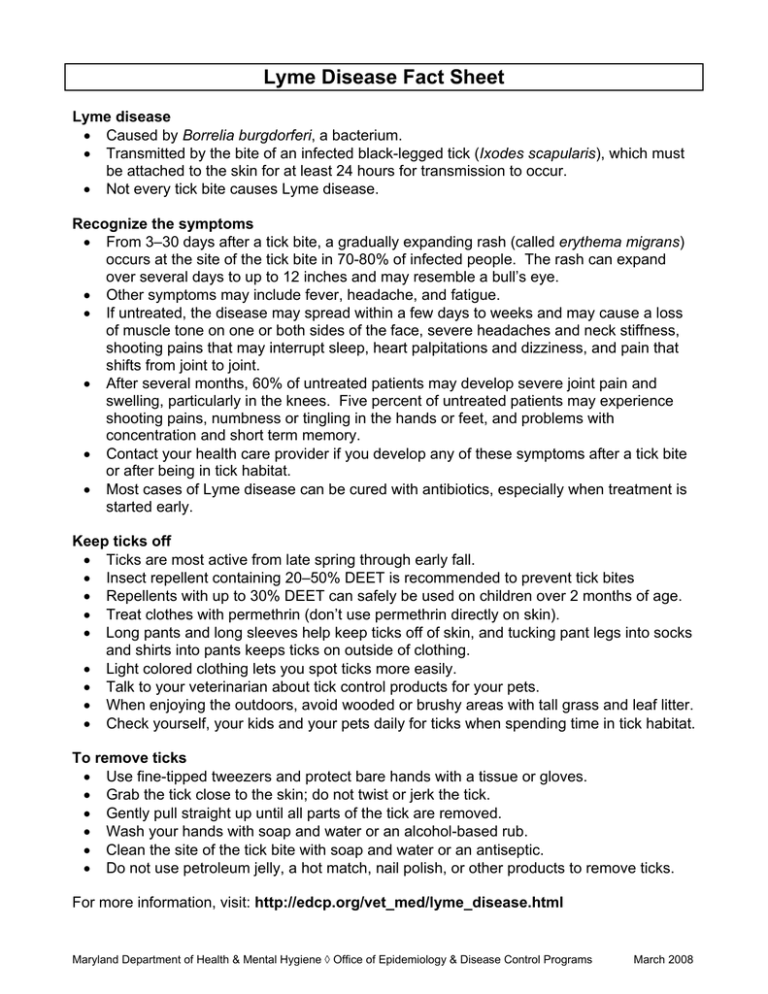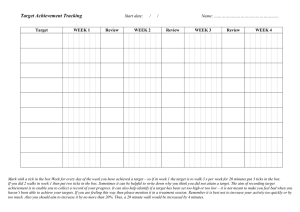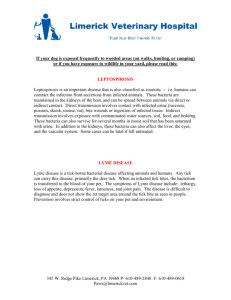Lyme Disease Fact Sheet
advertisement

Lyme Disease Fact Sheet Lyme disease • Caused by Borrelia burgdorferi, a bacterium. • Transmitted by the bite of an infected black-legged tick (Ixodes scapularis), which must be attached to the skin for at least 24 hours for transmission to occur. • Not every tick bite causes Lyme disease. Recognize the symptoms • From 3–30 days after a tick bite, a gradually expanding rash (called erythema migrans) occurs at the site of the tick bite in 70-80% of infected people. The rash can expand over several days to up to 12 inches and may resemble a bull’s eye. • Other symptoms may include fever, headache, and fatigue. • If untreated, the disease may spread within a few days to weeks and may cause a loss of muscle tone on one or both sides of the face, severe headaches and neck stiffness, shooting pains that may interrupt sleep, heart palpitations and dizziness, and pain that shifts from joint to joint. • After several months, 60% of untreated patients may develop severe joint pain and swelling, particularly in the knees. Five percent of untreated patients may experience shooting pains, numbness or tingling in the hands or feet, and problems with concentration and short term memory. • Contact your health care provider if you develop any of these symptoms after a tick bite or after being in tick habitat. • Most cases of Lyme disease can be cured with antibiotics, especially when treatment is started early. Keep ticks off • Ticks are most active from late spring through early fall. • Insect repellent containing 20–50% DEET is recommended to prevent tick bites • Repellents with up to 30% DEET can safely be used on children over 2 months of age. • Treat clothes with permethrin (don’t use permethrin directly on skin). • Long pants and long sleeves help keep ticks off of skin, and tucking pant legs into socks and shirts into pants keeps ticks on outside of clothing. • Light colored clothing lets you spot ticks more easily. • Talk to your veterinarian about tick control products for your pets. • When enjoying the outdoors, avoid wooded or brushy areas with tall grass and leaf litter. • Check yourself, your kids and your pets daily for ticks when spending time in tick habitat. To remove ticks • Use fine-tipped tweezers and protect bare hands with a tissue or gloves. • Grab the tick close to the skin; do not twist or jerk the tick. • Gently pull straight up until all parts of the tick are removed. • Wash your hands with soap and water or an alcohol-based rub. • Clean the site of the tick bite with soap and water or an antiseptic. • Do not use petroleum jelly, a hot match, nail polish, or other products to remove ticks. For more information, visit: http://edcp.org/vet_med/lyme_disease.html Maryland Department of Health & Mental Hygiene ◊ Office of Epidemiology & Disease Control Programs March 2008




